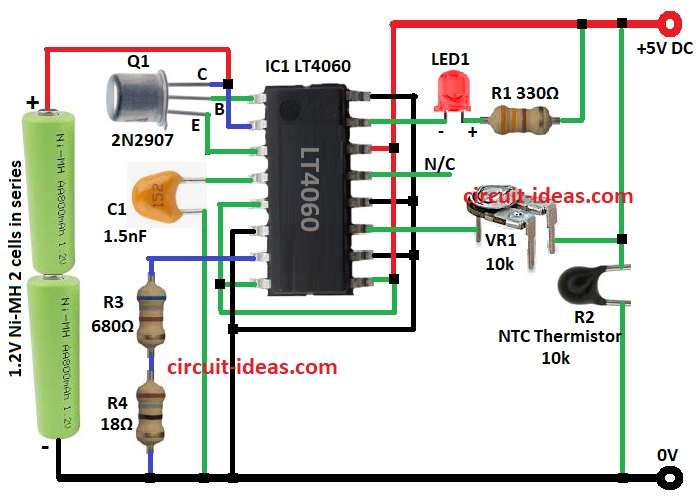Nickel Metal Hydride (Ni-MH) batteries are popular for small devices.
They give good power and can be charged again.
To keep them working long time, proper charging is very important.
The Ni-MH Battery Charger Circuit with IC LT4060 shows a strong charger using LT4060 IC from Linear Technologies.
This IC is made to charge 1.2V Ni-MH batteries well.
This article explains the charger circuit, how it works, its key formulas, how to build it and the final tips.
Circuit Working:

Parts List:
| Component | Value/Specification | Quantity |
|---|---|---|
| Resistors | 330Ω 1/4 watt , 680Ω + 18 = 698Ω 1/4 watt | 1 each |
| Preset 10k | 1 | |
| NTC Thermistor 10k | 1 | |
| Capacitors | Ceramic 1.5nF | 1 |
| Semiconductors | IC LT4060 | 1 |
| Transistor 2N2907 | 1 | |
| Battery Ni-MH in series 1.2V | 2 |
The circuit uses 5V DC power to Vcc pin of LT4060 chip.
This chip controls charging current using DRIVE pin and Q1 2N2907 transistor.
Charging current depends on resistors R3 and R4.
NTC thermistor R2 checks battery temperature.
If battery is too hot then chip stops charging to protect it.
LT4060 uses smart charging and first gives constant current till set voltage.
Then it changes to trickle charge to keep battery full.
Timer capacitor C1 sets max charging time to stop overcharge.
Time is calculated using special formula below.
Formulas and Calculations:
Below are simple formulas and values for Ni-MH battery charger:
Charging Current (Icharge):
Set by R3 and R4:
Icharge = 1000 / (R3 + R4) (in Amps)
If R3 = 680Ω and R4 = 18Ω
Icharge = 1000 / 698 = 1.43 mA
Charging Time (Tcharge):
Set by capacitor C1:
Tcharge = 3 × C1 × 10⁶ (in seconds)
If C1 = 1.5 nF
Tcharge = 3 × 1.5 × 10⁻⁹ × 10⁶ = 4.5 seconds
Battery Voltage (Vbattery):
Vbattery = N × Vcell
If N = 2 cells and Vcell = 1.2V
Vbattery = 2 × 1.2 = 2.4V
How to Build:
To build a Ni-MH Battery Charger Circuit following steps must be followed for building and connections:
- Gather all the components as per the circuit diagram
- Pin 1 (DRIVE) goes to base of Q1
- Q1 collector goes to pin 2 (BATTERY)
- Q1 emitter goes to pin 3 (SENSE)
- Pin 4 (TIMER) goes to one side of C1 and other side of C1 goes to GND
- Pin 5 (SHDN) ,pin 8 (ARCT), pin 9 (SELO) goes to +5V DC
- Pin 6 (PAUSE), pin 10 (SEL1), pin 12 (CHEM) go to GND
- Pin 7 (PROG) go to R3 and R4 in series go to GND
- Pin 11 (NTC) goes to one leg of VR1 and other leg of VR1 go to +5V and R2 go to GND
- Pin 13 (ACP) is not connected (N/C)
- Pin 14 (VCC) goes to +5V DC
- Pin 15 (CHRG) goes to negative of LED1 and positive of LED1 goes to R1 and +5V DC
- Pin 16 (GND) goes to GND of circuit
Conclusion:
This Ni-MH Battery Charger Circuit with IC LT4060 is simple and works well.
It has safety, checks temperature and time so battery stays safe.
It is good for toys, gadgets and backup systems.
If build correct then it gives strong and safe charging.
Leave a Reply